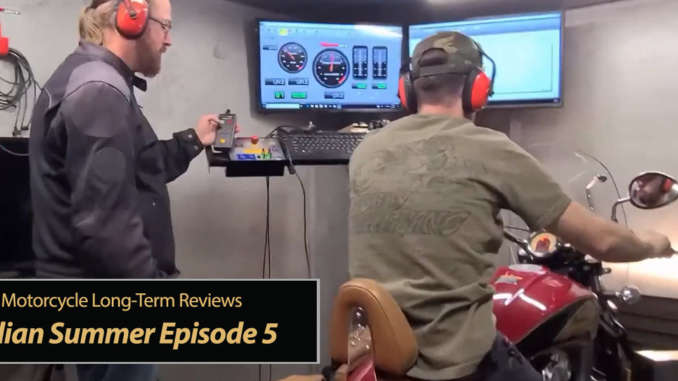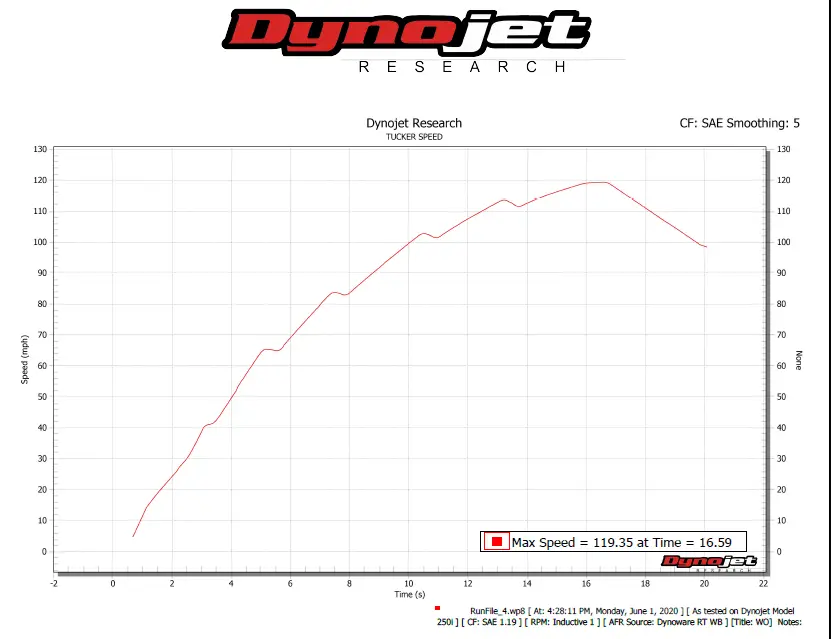
There’s nothing quite like a dyno run when reviewing a bike. It’s one thing to try to explain how much horsepower a bike has, and how it delivers that power. It’s quite another to have numbers in black and white that illustrate your description. We took the Indian Scout to a local speed shop, Tucker Speed, and got some solid numbers to show you. Scout Horsepower Dyno Runs are a go!
(editor – Readers, you are in for a real treat as Eric brings the Scout to the Dyno and puts it through it’s paces! If you like what you see and want to see more Dyno runs (they are not cheap), please consider supporting us at Patron for just $1 a month)
Watch our Video right here
Machine Learning – A Dyno Does What?
Getting a bike tested on a dynamometer – or dyno in the popular vernacular – is a great way to visualize it’s power output. We all know the common terms you can use to describe power deliver, right? Torque wave. Twitchy. Freight train. Fizzles. These are all ways to describe how a bike feels under you while you’re exercising your right wrist. But they’re subjective terms, imprecise at best and cliche at worst. They only mean something if you trust the reviewer.
Putting a motorcycle on a dyno, though, is the opposite of subjective. A dynamometer is a precise, calibrated machine that measures power output. The drive wheel rests atop a spinning drum, which measures the amount of force applied to it. An inductive pickup feeds engine rpm to the machine as well, so horsepower can be indexed to engine speed. Some machines also read exhaust gas chemistry so they can measure fueling throughout the rev range. That is, how the air fuel mixture is adjusted by the EFI on the fly.

Horsepower In, Horsepower Out
Manufacturers supply horsepower and torque numbers for their machines though, don’t they? They do, but typically those measurements are taken “at the crank”. This means they’re measuring the power put out directly by the engine. It’s a valid number, sure, but it doesn’t include the power losses through the rest of the drive train. Transmission, final drive, axle. To get a good measurement of how much power your bike delivers to the pavement, you have to take your reading at the wheel itself. That’s real world. That’s down to the ground.
For our 2019 Indian Scout, published horsepower and torque numbers are as follows:
Horsepower: 100hp @ 8,100 rpm
Torque: 72 ft-lbs @ 6,000 rpm
Bring in the Scout
Let’s just jump right into our results, shall we? Here’s the actual dyno we captured from a 4th gear roll-on with our Scout.

You can see the final numbers on the bar across the bottom of the graph. Our Scout achieved 88.2 horsepower @ 7,150 rpm. That’s both a little lower than the 100 hp reported by Indian, and it came earlier in the rev range. As we stated above, measurements taken at the wheel will usually be lower than at the crank. This accounts for losses in the final drive components, and it’s still pretty close to the numbers Indian provided.
Torque numbers, though, show a lot of difference. The Scout’s torque measurement itself is pretty close, 68 instead of 72 but at almost half the rpms. Peak torque comes on very early in the rev range, 3,390 rpm, and more importantly it stays high all the way through. The output shows a long, steady torque wave around 65 ft-lbs from 3,390 all the way to ~7200 rpm.
What that translates to is what we’ve been saying since our first write-up about the Scout. The power delivery is incredibly linear, no surprises, no drama. It doesn’t fluctuate, it doesn’t bottom out, it doesn’t jag or jitter. One long wave of power you can surf on while grinning ear to ear. Results like these are why it’s so great to have a dyno test.
There is, however, a dip worth mentioning. You can see in the chart above that torque and horsepower both sustain a shallow dip from just after the torque peak until about 4,800 rpm. Then they recover and stay very linear. This is most likely a small leaning out in the fuel map, and it’s pretty typical. I can tell you I don’t feel it on the Scout at all.
The Sprint
Some backstory is in order here, so you’ll understand why we did this next bit.
I’ve been saying from the beginning we really wanted to take the Scout to a drag strip while we had it for review. This almost panned out. Very close to us is Hypoxia Dragway, a 1/8th mile strip just outside of Evanston, Wyoming. They do really casual, informal races through the summer season, no purses or leagues or anything, just pay and go. Unfortunately, the one test-n-tune they were holding in May got snowed out, so we weren’t able to pull this off.
So, since I really wanted some some acceleration numbers, I asked Tony, our tech at Tucker, if he could humor us with some timed runs on the dyno once our power numbers were done. This is not something normally done on a dyno, but he agreed and we had a lot of fun trying it. To simulate wind resistance – which is the primary thing missing from an acceleration test when conducted on a dyno – I turned up the resistance on the drum by 3% every time Tony shifted. That meant we were at 15% resistance after the shift into 6th gear, which is reported to be a pretty good analog for freeway speeds as far as throttle response.
All that is to say this is a very sketchy way to capture acceleration curves, but we had fun with it and we decided it would make for good content. Here’s the graph:

The first thing you’ll notice is the shifts, of course. After each shift is a dip, which gets more severe each time. That’s the resistance building on the drum.
Reading this graph, we see that the Scout achieved a 0-60 time of about 4.8 seconds, and a 0-100 time of 10 seconds. Top speed was 119 mph in 16.5 seconds, which was the highest speed reached before finding the rev limiter.

Please and Thank You
Being able to do things like this is a blast, and it’s a big deal. It makes for excellent content, and we’re really excited to be able to bring it to you.
We want to say thank you to the Patreon contributors and our fans who share our stuff in their networks. Our most important currency is influence, with which we can line up all sorts of arrangements with manufacturers, shops, and venues. And where influence fails, cold hard cash always talks.
If you know the folks out at Tucker Speed in Ogden, Utah, give them a call and tell them you saw this TMW article. And if you enjoyed this content, please consider heading over to Patreon and subscribing. With more resources we can bring you more content.
And head into the Forums! Join and sound off, tell us what you want to see more of, what you liked, what you didn’t like!
We hope you enjoyed reading and watching An Indian Summer Ep5: Scout Horsepower Dyno Runs! Stay tuned TMW fans at next week we bring you yet another exciting new episode installment. Same TMW time, same TMW channel.
Eric Leaverton is a management and labor relations specialist from the city of Harrisville, Utah, United States. He is an avid reader of fiction and non-fiction, and in his spare time enjoys riding motorcycles with his wife and raising their three children. Eric is also a product reviewer and field correspondent for Total Motorcycle Web. For more pictures, stories, and background, you can read his blog in the Total Motorcycle forums here:
To Ride An Iron Horse (link opens in new tab)



